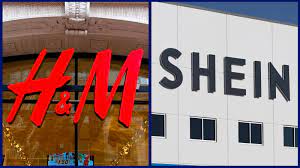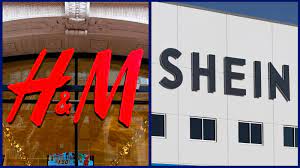
Pop legend Cher, Swedish singer Robyn, and South Korean DJ Peggy Gou entertained a group of stars and models, including Jared Leto, Elle Fanning, and Irina Shayk, at the Silencio nightclub during Paris Fashion Week.
They were all dressed in glittering ensembles from H&M's most recent partnership, a line including the late fashion designer Paco Rabanne, who popularised sequins and metal chainmail in the 1960s.
The clothes retailer from Sweden threw a star-studded event to try and appeal to more aspirational customers in an effort to recover its profit margins and steer clear of direct conflict with fast-fashion behemoth Shein.
The business is being turned upside down by the quick expansion of this China-based internet store that sells $5 t-shirts, $2 jewellery, and $8 dresses.
With an estimated 18% market share, Shein—which intends to go public next year—is currently the largest fast-fashion retailer in the world, ahead of Inditex, the company that owns Zara, with 17%, and H&M, which comes in at 5%, according to Coresight Research.
Furthermore, Shein poses a challenge to those companies in their primary market: data.ai indicates that the app's user base in the region is more European than American, and since January 2022, it has more than doubled to 65.5 million monthly active users.
"There's no doubt that Shein is a disruptor. They have come into the market and grown very fast, which I'm sure has surprised H&M," said Adil Shah, portfolio manager at Storebrand in Oslo, which holds H&M shares.
Offering consumers "the best combination of fashion, quality, and sustainability, at the best price" is still H&M's stated goal, the company said on Friday.
The business's fourth-quarter sales dropped by 4%, allowing Zara to overtake it. In the most recent quarter, Inditex, the parent company of Zara, reported 7% rise in sales.
Given that its clientele is generally more price-sensitive than Zara's, H&M raised their pricing later than Zara when inflation drove costs up last year.
However, it was able to enhance its operating margin this year from 3.9% during the same period last year to 5.9% for the first nine months of its financial year thanks to price rises and decreased discounting.
H&M, Gap, and other conventional high-street retailers are all losing market share to Shein, according to Alistair Wittet, portfolio manager at Comgest in Paris; however, Zara is less immediately challenged because its clientele is primarily white-collar.
"I would be very surprised if Zara were to lose share in the coming years," Wittet said. "I don't doubt that Shein will grow faster, but Zara will continue to outperform the broader apparel industry."
H&M is attempting to draw in more aspirational customers by imitating its Spanish competitor, who has effectively improved its reputation through marketing and store improvements.
A 10% operating margin is a goal that investors appear certain H&M can achieve in 2024; the company's shares have increased by almost 60% this year, outpacing Inditex. Nonetheless, Zara's parent company is valued more highly than H&M.
According to Shah of Storebrand, H&M is attempting to release new collections onto the market more quickly in order to more effectively rival Zara and companies like Shein.
As a response to Shein's explosive growth, which has increased competition in the lower-end market, Barclays analyst Nicolas Champ noted that H&M is attempting to set itself apart by enhancing its brand and expanding the fashion section of its selection with the Rabanne collection.
Although its pricing points are significantly higher than the average for the retailer, H&M claims that its designer collaborations "clearly show that design and sustainability are not a matter of price".
A $749 metallic mesh dress composed of aluminium, a $399 sequin disc mini-dress, $299 purple sequin pants and $399 silver cowboy boots are among the items in the collection.
Price hikes may make H&M less competitive, according to RBC analysts, but they also pointed out that the company's luxury brand Cos's strong success indicates that consumers are willing to pay more for certain goods.
(Source:www.beamstart.com)
They were all dressed in glittering ensembles from H&M's most recent partnership, a line including the late fashion designer Paco Rabanne, who popularised sequins and metal chainmail in the 1960s.
The clothes retailer from Sweden threw a star-studded event to try and appeal to more aspirational customers in an effort to recover its profit margins and steer clear of direct conflict with fast-fashion behemoth Shein.
The business is being turned upside down by the quick expansion of this China-based internet store that sells $5 t-shirts, $2 jewellery, and $8 dresses.
With an estimated 18% market share, Shein—which intends to go public next year—is currently the largest fast-fashion retailer in the world, ahead of Inditex, the company that owns Zara, with 17%, and H&M, which comes in at 5%, according to Coresight Research.
Furthermore, Shein poses a challenge to those companies in their primary market: data.ai indicates that the app's user base in the region is more European than American, and since January 2022, it has more than doubled to 65.5 million monthly active users.
"There's no doubt that Shein is a disruptor. They have come into the market and grown very fast, which I'm sure has surprised H&M," said Adil Shah, portfolio manager at Storebrand in Oslo, which holds H&M shares.
Offering consumers "the best combination of fashion, quality, and sustainability, at the best price" is still H&M's stated goal, the company said on Friday.
The business's fourth-quarter sales dropped by 4%, allowing Zara to overtake it. In the most recent quarter, Inditex, the parent company of Zara, reported 7% rise in sales.
Given that its clientele is generally more price-sensitive than Zara's, H&M raised their pricing later than Zara when inflation drove costs up last year.
However, it was able to enhance its operating margin this year from 3.9% during the same period last year to 5.9% for the first nine months of its financial year thanks to price rises and decreased discounting.
H&M, Gap, and other conventional high-street retailers are all losing market share to Shein, according to Alistair Wittet, portfolio manager at Comgest in Paris; however, Zara is less immediately challenged because its clientele is primarily white-collar.
"I would be very surprised if Zara were to lose share in the coming years," Wittet said. "I don't doubt that Shein will grow faster, but Zara will continue to outperform the broader apparel industry."
H&M is attempting to draw in more aspirational customers by imitating its Spanish competitor, who has effectively improved its reputation through marketing and store improvements.
A 10% operating margin is a goal that investors appear certain H&M can achieve in 2024; the company's shares have increased by almost 60% this year, outpacing Inditex. Nonetheless, Zara's parent company is valued more highly than H&M.
According to Shah of Storebrand, H&M is attempting to release new collections onto the market more quickly in order to more effectively rival Zara and companies like Shein.
As a response to Shein's explosive growth, which has increased competition in the lower-end market, Barclays analyst Nicolas Champ noted that H&M is attempting to set itself apart by enhancing its brand and expanding the fashion section of its selection with the Rabanne collection.
Although its pricing points are significantly higher than the average for the retailer, H&M claims that its designer collaborations "clearly show that design and sustainability are not a matter of price".
A $749 metallic mesh dress composed of aluminium, a $399 sequin disc mini-dress, $299 purple sequin pants and $399 silver cowboy boots are among the items in the collection.
Price hikes may make H&M less competitive, according to RBC analysts, but they also pointed out that the company's luxury brand Cos's strong success indicates that consumers are willing to pay more for certain goods.
(Source:www.beamstart.com)














